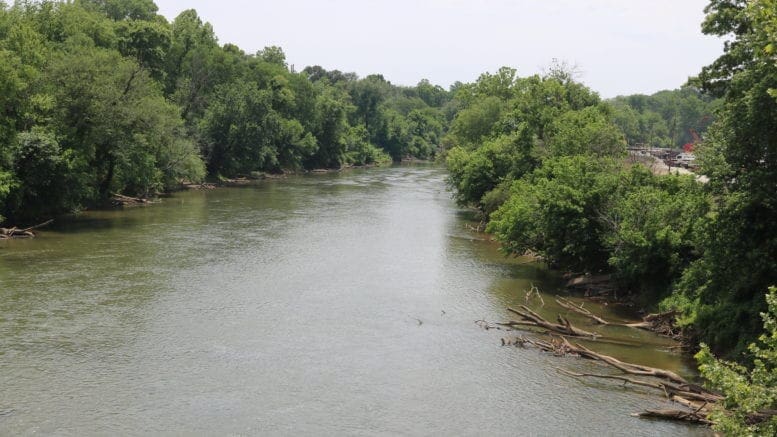Photo: Chattahoochee River from the Hwy 278 bridge looking southward — Larry Felton Johnson
The Friends of Smyrna Library will hold a lecture this Sunday on the Civil War fortifications known as the shoupades, which formed a defensive network called “The Chattahoochee River Line.”
The line ran from Vinings, through the outskirts of Smyrna, and south of what is now Veterans Memorial Highway in Mableton.
The lecture will be on Sunday, July 14, 3:00-4:00 p.m. in the Smyrna Library Meeting Room.
View Larger Map
Light refreshments will be served.
The Facebook page for the event gives the following description:
Join us as Phil Ivester, Concord Covered Bridge Historic District Board President, discusses his research into the Chattahoochee River Line troop movements and battles during the Civil War in the summer, 1864.
We will share first person narratives by soldiers who were there.
Smyrna-native Philip Ivester, serves as CEO of Kennesaw-based Energy Management firm. His degree is in Electrical Engineering from Georgia Tech, but he is passionate about Smyrna history, having grown up in the historic Martin Luker Ruff house near the Concord Woolen Mill, Grist Mill, and Covered Bridge.
Over the years he has done extensive research into the history of 19th-century communities known as Concord, Millgrove, Nickajack, and Tillman. He is President of the Friends of the Concord Covered Bridge Historic District and Treasurer of the Smyrna Historical Society.
What are the shoupades?
Shoupades were a unique series of fortifications built during the Civil War along the Chattahoochee River one month prior to the Battle of Atlanta. Construction was supervised by their designer, Confederate Brig. Gen. Francis Shoup. Shoup was under the command of General Joseph Johnston, so the entire row of fortifications became known as Johnston’s River Line.
Thirty-six shoupades were built. Nine remain today in the form of earthwork mounds that served as the foundation for small triangular wooden forts. The complete structures, earthen and wooden, were 16 feet tall, with ledges for riflemen and a ground-level interior for the soldiers who reloaded the rifles. The individual forts were arranged in a sawtooth pattern to catch advancing enemy troops in crossfire. Each shoupade would hold about 80 soldiers.
Civil War historian Michael Shaffer, in an interview with the Courier conducted at Kennesaw State University a few years ago, explained the decision to build them, and how construction began.
“Shoup had the idea for this very unique series of fortifications … He received approval from Johnston, in mid-June of 1864 … Shoup originally envisioned a line stretching for about four miles, which would have covered a point slightly above the Western & Atlantic railroad crossing of the Chattahoochee River. And that was really their major concern. They wanted to protect the rail line, because the Western & Atlantic and trains out of Atlanta supplied the Confederate army.”
Shaffer said the construction was done by about 1,000 enslaved persons, along with injured soldiers recruited from local military hospitals. At Johnston’s request the line was extended to six miles, to include a ferry crossing on the road that later became Bankhead Highway, and later still Veterans Memorial Highway.
Sherman wrote after the war that the shoupades were “the best line of field entrenchments I have ever seen.” But the shoupades were never tested in combat. Faced with a difficult obstacle, Sherman did the sensible thing, and went around them, crossing the river to the north.
